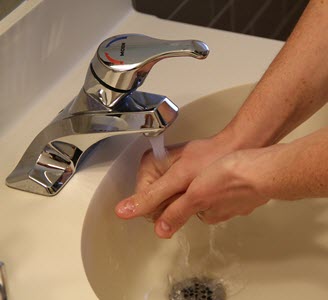Six Steps to Proper Handwashing in the Food Service Industry
Posted on 6th Apr 2018

If you’re in the foodservice industry, especially involved with food preparation, proper handwashing is very important. While office workers and those working in most all other industries can get by just remembering to sing Happy Birthday to themselves twice as they wash (the oft-cited way to measure the full 20 seconds required to effectively wash hands), for food service workers, singing Happy Birthday twice just won’t make the grade.
Here are the six steps we need to follow for effective handwashing. Following these six steps will help ensure your hands are clean when handling food items and when working in a commercial kitchen:
- Wet your hands first before applying any soap. Do not use hand soap—it is best to squirt liquid hand soap onto your hands from a dispenser near the sink.
- Rub your hands together palm to palm. Not only does this clean the palms, but it builds up the soap lather so that it can be used on other areas of the hands. This is also a good time to rub the tips of your fingers in the palm of your hand, which helps clean under the nails.
- Rub the palm of one hand along the back of the other; be sure to include the fingers. Then repeat the process with the other hand.
- Here’s where things get tricky: interlock your hands with your left-hand fingers (except the thumb) pointing to the right and your right-hand fingers (again without the thumb) pointing to the left. While in this interlocked position, push and pull the hands to clean the sides of the fingers.
- Rub your thumbs on each palm to make sure they are cleaned
- Rinse off your hands thoroughly and then dry with a disposable hand towel. Rinsing and drying are very important: rinsing removes chemical residue—which attracts soils to hands like a magnet—while wet hands are more likely to gather dust and soils to the hands than dry hands. Once hands are dry, use the hand towel to turn off the faucet if it is manually operated.
Another thing we should discuss is the use of hand sanitizers in the foodservice industry. Hand sanitizers do not replace hand washing, as they are not designed to remove soil and contaminants from hands. They can kill most surface-level germs and bacteria, but our hands have layers, creases, and folds where germs and bacteria can be tucked away.
Further, the hands of food service workers are often wet and may contain substances such as fatty materials, blood, oil, and/or grease. Hand sanitizers lose their effectiveness when hands are wet or these substances are present on the hands.
The only way to thoroughly remove soils and contaminants from hands is by following the six handwashing steps discussed here.
For more information on how to keep food service facilities clean and healthy, contact a DayMark representative.


